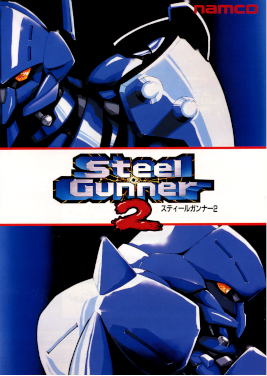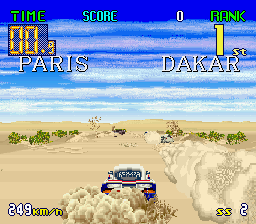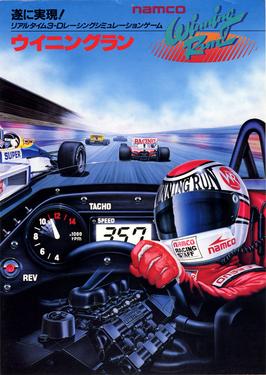
Super Sprint is a racing video game released by Atari Games and Midway Games in 1986. Up to three players drive Formula One-like cars on a circuit that is viewed from above. The game is a successor to Gran Trak 10 and the Sprint series, which were black-and-white games from the 1970s. A sequel, Championship Sprint, was released later in the same year.

Hot Chase is an arcade game released in 1988 by Konami. In the game, players drive a white Porsche 959 out of an enemy country to the Border crossing of a friendly one. The car has a bomb attached to it that explodes in a set time. If the bomb explodes, players must restart. There are many obstacles along the way, including railroad crossings, military checkpoints, helicopters that shoot at the car and other cars. The gameplay is said to be similar to Chase H.Q..

Ridge Racer 2 is an arcade racing game that was released by Namco in 1994 for their System 22 hardware. Despite its name, Ridge Racer 2 is more of an updated version of Ridge Racer, than an actual sequel.

Hot Rod is a top-down arcade racing game developed by Sega. Released for arcades in 1988 in Japan and released worldwide in 1989, the game was available in a four-player cocktail-style arcade cabinet, as well as a three-player upright cabinet. Home computer ports were published by Activision in 1990 for the Amiga, ZX Spectrum, Amstrad CPC, Commodore 64, and Atari ST.

Pole Position II is the sequel to racing simulation game Pole Position, released by Namco for arcades in 1983. As with its predecessor, Namco licensed this game to Atari, Inc. for US manufacture and distribution. Atari Corporation released a port as the pack-in game for its Atari 7800 ProSystem console launch in 1986. Pole Position arcade machines can be converted to Pole Position II by swapping several chips.

Final Lap 2 is an racing simulation game released by Namco for arcades in 1990. It is the arcade sequel to Final Lap and runs on Namco System 2 hardware.

Final Lap 3, as the name suggests, is the third title in the Final Lap series, released worldwide by Namco in 1992; like its precursors, it runs on Namco System 2 hardware, and allows up to eight players to play simultaneously when four two-player cabinets are linked together.

Dirt Fox is a 1989 racing arcade game developed and published only in Japan by Namco. It runs on Namco System 2 hardware, and allows up to four players to play simultaneously, when four cabinets are linked together they can allow up to eight players to play simultaneously, when four two-player cabinets are linked together.

Steel Gunner 2 is a 1992 first-person shooter game developed and released by Namco for arcades. It is the sequel to Steel Gunner, which had been released in 1990. It was also sold as a conversion kit for Taito's Operation Thunderbolt (1988).

Aqua Jack is a 3D shoot 'em up arcade video game released by Taito in 1989. A hovercraft is piloted over water and land while dodging bullets and avoiding objects by shooting or jumping over them. Enemies are shot in the air and on water or land to advance levels. The game has eight levels.

GP Rider is a motorcycle racing game developed and manufactured by Sega, released in as an arcade video game in Japan, North America and Europe. It came in a two-player motion simulator cabinet and a standard upright cabinet. It was ported to the Master System in 1993 and then Game Gear in 1994.

Big Run is a rally racing arcade video game released by Jaleco in 1989. Rendered in 3D, the game is the first to be set in the Paris-Dakar rally raid which the player drives a Porsche 959, resembling that of the 1986 winner. Opponents in the game resemble Peugeot 205 T16s, which went on to win in the 1987 Paris-Dakar rally, with Mitsubishi Pajeros also appearing occasionally.

Buggy Boy, known as Speed Buggy in North America, is an off-road racing game developed by Tatsumi and released for arcades in 1985. The cockpit version of the arcade cabinet has a panoramic three-screen display, a feature previously employed in TX-1, but with Buggy Boy having a larger cabinet. An upright, single-screen cabinet was released in 1986 under the name Buggy Boy Junior.

Konami GT, originally known as Konami RF2 - Red Fighter, is a 1985 racing video game developed and released by Konami, using their GX400 arcade architecture. The player drives a sports car which must reach various checkpoints without running out of fuel. A turbo mode increases the car's speed but uses more fuel and puts the player at a higher risk of hitting an obstacle. Fuel power-ups can be found on the road which the player must pick up to make it to the final checkpoint.

Monaco GP is an arcade racing game released by Sega in November 1979 in Japan, and January 1980 worldwide. An upgraded version, Pro Monaco GP, was released later in 1980. One of the last Sega games to use TTL chips instead of a microprocessor CPU, the game has players race against a clock and pass rival racers while attempting to earn points driving through five areas.

Star Wars: Return of the Jedi is an isometric scrolling shooter released as an arcade video game in 1984 based on the film from the previous year. It was the second arcade release by Atari based on the Star Wars franchise, but using raster graphics rather than the vector graphics of the first and third arcade games. Several home ports were released by Domark for the Amstrad CPC, BBC Micro, ZX Spectrum, Atari ST, Commodore 64, and Amiga in 1988. The game is included as an unlockable extra on Star Wars Rogue Squadron III: Rebel Strike for GameCube.

Driver's Eyes is a 1991 3D driving simulation arcade game developed and published in Japan by Namco. The game has a pseudo-panoramic view using three CRT screens; the player would sit in a then-realistic Formula One car cockpit with LCD instruments. The game would start with the player selecting either "easy drive" or "technical drive". Once the selection was made the screen would show a 3D model of a Formula One car with a V8 engine being placed into the engine bay and then the body work gliding down. As that happened the camera view would change and reveal a sign saying "BRAKES ON". When the sign lifted the race would start.

Winning Run is a first-person arcade racing simulation game developed and published by Namco in late December 1988 in Japan, before releasing internationally the following year. The player pilots a Formula One racer, with the objective being to complete each race in first place, all while avoiding opponents and other obstacles, such as flood-hit tunnels, pits and steep chambers. It was the first game to run on the Namco System 21 arcade hardware, capable of 3D shaded polygons.

Gun Buster, also known as Gunbuster (ガンバスター) and released in North America as Operation Gunbuster, is a first-person shooter video game developed by Taito and released for arcades in 1992. In contrast to on-rail light gun shooters at the time, this was one of the first arcade games to feature free-roaming FPS gameplay, the same year Wolfenstein 3D was released on personal computers.

F1 Exhaust Note is a two-player racing game released for arcades in 1991, modeled on Formula One racing. The game has a standard dual racing cabinet setup. Each player station has a 25-inch monitor, steering controls, shift controls, pedals, and a decorative seat. The sound originates from the back of the seat giving the player surround sound effect. The game ran on the Sega System 32 arcade hardware.






















